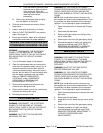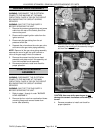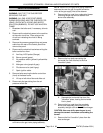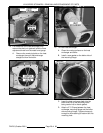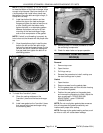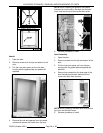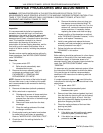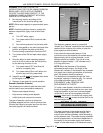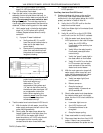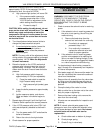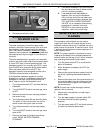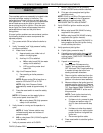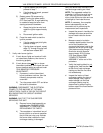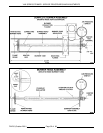
VHX SERIES STEAMER - SERVICE PROCEDURES AND ADJUSTMENTS
F24700 (October 2001)Page 25 of 68
used, a frequent interval should be used. This
blowdown procedure is essential
to proper operation
and component life by removing sediment and
scalants that may be lodged in the probe housing.
NOTE:
Boiler should be within normal operating
pressures.
1. Remove the left side boiler base panel to
access the ball valve.
2. Turn the power switch ON and allow the boiler
to reach operating pressure.
WARNING:
THE STEAMER AND ITS PARTS ARE
HOT. USE CARE WHEN OPERATING, CLEANING
OR SERVICING THE STEAMER. THE BOILER
CONTAINS LIVE STEAM. STAY CLEAR WHEN
OPENING THE VALVE.
3. Open the ball valve for approximately one
minute while under pressure to thoroughly flush
the probes and housing.
4. Close the ball valve and replace left side panel.
5. Press the reset switch (manual) on the boiler
control panel and allow boiler to reach
operating pressure.
6. Steamer is now ready for use.
WATER LEVEL CONTROLS
TEST
The procedure below applies to the water level
control boards for both the old and new style boiler
controls. For additional information related to the
new style controls, refer to "RELAY BOARD" and
"SEQUENCE OF OPERATION" under
"ELECTRICAL OPERATION". For specific
information related to the water level controls
operation, refer to "WATER LEVEL CONTROLS"
under "ELECTRICAL OPERATION".
Loose electrical connections may prevent the
steamer from operating properly.
An accumulation of lime scale on or near the water
level sensing probes may cause them to retain
water (moist) on the probe surface and give a false
reading. Also, a cracked or damaged insulator may
give a false reading.
These conditions may cause one or more of the
following to occur:
• Gas burner no ignition
• Boiler no fill
• Boiler overfill.
• Boiler no fill and dry fire
NOTE
: Dry firing may cause damage to the heat
exchanger, burner assembly or the boiler. If this
condition is suspect, the affected components
should be inspected.
WARNING:
THE FOLLOWING STEPS REQUIRE
POWER TO BE APPLIED TO THE UNIT DURING
THE TEST. USE EXTREME CAUTION AT ALL
TIMES.
Main Water Level Control
NOTE:
The main water level control is a dual
functioning control that provides for low level cut-off
protection and differential water level control
1. Turn power switch ON and verify:
A. Low water light is illuminated (front control
panel).
B. HL LED is illuminated on the water level
control board.
C. Boiler is filling with water.
1) If boiler isn’t filling with water:
a. Verify 120 Volt AC is being
applied to the fill valve.
b. Verify fill valve isn’t clogged.
c. Verify 120 Volt AC is on main
water level control board.
2) If water level control board doesn’t
have 120 Volt AC:
a. Check it’s power source at the
10 pin J3 connector, pin 1
(white) and pin 2 (black).
Disconnect the 10-pin J3
connector from the relay board
in the main boiler control box.
b. If no voltage is measured on J3
pins 1and 2, check the F1 fuse
(resettable circuit breaker) in the
main control box, and the power
switch connections in the power
switch box.
c. If 120 volt AC was measured on
J3 connector pins 1 and 2 but
not on the water level control
board, verify wire connections.
There should be continuity
between L1 on the water level
control board and J3 pin 7.
There should also be continuity
between L2 on the water level
control board and J3 pin 6. This
path includes connections thru
the J1 connector.
2. At the end of the initial fill:
A. Verify approximately one inch of water
visible in the boiler sight glass.
B. Verify "green" ready light in the reset
switch is illuminated.



